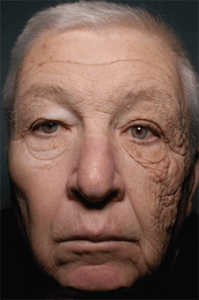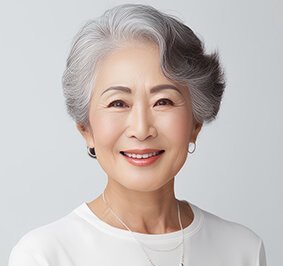
The Burning Issue 2
UV and Skin AgingUV and Skin Aging
Tanning and the Beauty Myth
 A truck driver whose skin on one side of his face was exposed to UV over many years of driving. Photo by Jennifer Gordan, MD.
A truck driver whose skin on one side of his face was exposed to UV over many years of driving. Photo by Jennifer Gordan, MD.It’s somewhat ironic that far too many fair-skinned Caucasians view tanned skin as youthful, healthy and attractive; for some, it’s part of their beauty regime. One just needs to look at adverts for female swimwear or see influencers on social media lounging poolside, or at exotic beaches, sporting sun bronzed skin to establish the promotion of tanning is far too common. In 2023, given the growing awareness around UV and skin cancers, you’d think that attitudes might have changed; however, social media tells a very different story. Type the word “tanning” into the search bar on TikTok and you’ll find countless videos glamorising tanned skin. The irony is that these typically young and beautiful female influencers are promoting deadly skin cancers and high degrees of premature skin aging to their followers. It’s ultimately a hedonistic and contradictory thing. On the one hand, a tan is promoted as youthful, healthy and beautiful, while on the other hand, medically speaking, tanning is potentially deadly and prematurely degrades youth and beauty due to 80% of skin aging being linked to UV exposure – the very same thing that is required for tanning.
Let’s make this very clear and simple. There is no safe way of tanning. A tan is a sign of skin damage. Any method of tanning that involves exposure of the skin to ultraviolet (UV) radiation, either by sunlight or solarium, will cause skin damage. Tanning is a photoprotective response to UV-induced DNA damage. Some believe that a tan protects you from sunburn. This is a fallacy. A tan only offers extremely limited protection (SPF3) against sunburn. In an experiment where skin was irradiated with either UVA or UVB to induce a tan, subsequent exposure to a dose of UV showed that UVA tans confer no photo-protection, while UVB-induced tans are only minimally protective against UV.
UV and Skin Aging
Skin aging can be divided into two basic processes, intrinsic aging and photoaging. Intrinsic aging of the skin occurs over the passage of time. Intrinsic aging is characterized by smooth, dry, pale and finely wrinkled skin. Photoaging describes premature skin aging in sun damaged skin. Photoaging is characterized by severe wrinkling and skin pigment changes, such as mottled pigmentation on sun exposed areas of the body such as the face, neck and forearms. UV radiation is the key causative factor for photoaging[1]. In Caucasians as much as 80% of the skin changes we associate with age are actually caused by the suns UV rays[2]. However, photoaging can be prevented. It occurs over time with cumulative UV exposure. With UV protection practices started early in life, most photoaging can be prevented.
UVA and UVB in Photoaging
The UV radiation (UVR) of concern in photoaging is classified into UVA and UVB; each has distinct effects on the skin. UVB radiation is more cytotoxic and mutagenic than UVA and, according studies, is 3-4 orders of magnitude more effective per unit physical dose than UVA for DNA photodamage. UVB primarily affects the skin’s outer layer causing sunburn and also long term, cumulative skin damage, while also being the key UV in the suns spectrum that causes skin cancers. However, UVA rays penetrate the skin more deeply than UVB, causing long-term damage and contributing greatly to skin aging. It has been estimated that 50% of UVA exposure occurs in the shade[3]. This basically means that even when people think they are protected from UV photoaging, this may not be the case.
Skin is composed of three layers: the epidermis, or outermost layer; the dermis, or middle layer; and the hypodermis, which is also named the subcutis, or bottom most layer of the skin. One of the key ways through which UV accelerates skin aging is through the production of free radicals. These unstable molecules can damage cellular structures, including collagen and elastin. It is these elements (collagen and elastin) that give skin its smooth and youthful appearance. Repeated exposure to UV causes skin aging which is compounded with natural aging over the passage of time. As a result, areas of the body that are frequently exposed to the sun such as the face, neck, forearms, or back of the hands acquire visible signs of aging more rapidly than other areas of the body. Years of exposure to both UVA and UVB damages cells on the epidermis (top layer of skin). When this occurs, the skin starts to look red, rough and scaly in patches – a condition called actinic keratosis (AK). If you have AK on your skin it is one of the most common skin conditions that dermatologists treat[4]. It is estimated that more than 40 million Americans develop AK each year.[5] On the other hand, UVA is able to penetrate deep into the dermis. The dermis consists of fibres, elastin and cells; it also contains the epidermal adnexa, the arrector pili muscles, blood and lymph vessels, and nerve fibres. About 90% of these fibres are collagenous. Due to UVA penetrating deep into the dermis, it damages the collagen fibres. This damage causes increased production of abnormal elastin. The abnormal amounts of elastin results in the production of enzymes called metalloproteinases. These enzymes, which rebuild damaged collagen, often malfunction and degrade the collagen, resulting in incorrectly rebuilt skin. As this process is repeated with daily UVA exposure, depleted collagen results in wrinkles and leathery skin.[6]
Photoaging in Darker Skinned Populations
I think it’s generally agreed that people with naturally darker skin tend to age better – a least where skin aging is concerned -than people with fairer skin. There is a scientific reason for this. In humans, melanin levels are the determinant of skin colour. People with dark skin have higher levels of melanin than white Caucasians and as result they are less susceptible to photoaging. The shielding effect of melanin and its role in reducing photoaging is achieved by its ability to serve as a physical barrier that prevents UVA and UVB penetrating the epidermis, thereby acting as a protective element against photoaging. One study notes that manifestations of skin aging in people with darker complexions is less severe and typically occur 10 to 20 years later than those of age-matched white individuals. [7]. However, higher levels of melanin does not prevent photoaging completely. Differences in the epidermal melanin make darkly pigmented skin more vulnerable to dyspigmentation (typically seen as grey or brown spots on the skin) [8] while also being subject to wrinkling caused by photoaging. For example, a 2003 study found that there was a significant positive association between wrinkling and dyspigmentation in both Korean women and men. This suggests that Korean people with severe dyspigmentation usually tend to have severe wrinkles, and that wrinkling is a major problem in photoaged Asian skin.[9]
According to Mintel, a global market intelligence agency, 85% of Japanese women and 36% of Japanese men use sunscreen for cosmetic purposes. The main objective is to prevent skin aging. There’s good reason for this.
Several studies have been performed in East Asian and South Asian subjects with darker skin types. A study in 14 elderly Japanese people with photoaged skin, investigated the effects of sunscreen application for 18 months. At the beginning of the study, subjects received instructions from the dermatologist on the proper method of application and were given a leaflet illustrating how much sunscreen to apply (2 mg/cm2). Despite this, there were large differences in total amount of sunscreen used among participants. After 18 months of sunscreen application, positive changes in the number of spots and skin tone uniformity during the study period showed good correlation with the amount of sunscreen used.[10] Other studies on Japanese people have found that sunscreen use reduced visible signs of aging [11][12]. Another study was conducted in India with 216 subjects, aged 18-45 years old, with skin pigmentation irregularities who did not previously use sunscreens. Participants were randomized to apply twice daily either sunscreen product A (sun protection factor 50 with high UVA protection) or sunscreen product B (sun protection factor 19 with high UVA protection) before sun exposure for above 2 hours for 12 weeks. The clinical assessment showed significant improvement in both groups [13]. These studies provide compelling evidence that regular use of sunscreen is effective in preventing the development of wrinkles and uneven pigmentation in different darker complexioned populations.
Preventing Photoaging
Preventing UV exposure is key to greatly reducing skin aging. This really comes down to covering up the skin with clothing and wearing a good high SPF, broad spectrum sunscreen on exposed skin while outdoors. In fact, many people praise sunscreen for being their go-to antiaging weapon, and for good reason. According to one study, people who used a low SPF, low UVA protection sunscreen on a daily basis experienced 24% less skin aging than those who used sunscreen only intermittently.[14]. As this study was performed between 1992 and 1996 with a SPF 16 sunscreen with low UVA protection, modern sunscreens with better UVA protection might be expected to be even more effective at preventing photoaging. This principle was demonstrated in a more recent study where daily use of a facial UVA/UVB broad-spectrum SPF 30 sunscreen in 32 subjects for 52 weeks significantly improved photoaging (overall photodamage, overall skin tone, crow’s feet, fine lines, mottled pigmentation, discrete pigmentation, evenness of skin tone, clarity, and texture). This study demonstrated that daily use of a facial broad-spectrum sunscreen can prevent uneven pigmentation and may visibly reverse the signs of existing photodamage, in addition to preventing wrinkles and further sun damage.[15]. In short, the higher the SPF and UVA protection a sunscreen provides the better the protection from photoaging.
Sunscreen Application Tips
Apply sunscreen 20 – 30 minutes prior to going outdoors into direct, intense sunlight
Reapply sunscreen every two hours.
Use sunscreen of SPF 30 or higher when going outside.
Make sure sunscreen is labelled “broad spectrum,” which means it protects against UVA and UVB rays. Because skin aging is caused by both UVB and UVA be sure that besides having a high SPF rating (which only relates to UVB protection), the sunscreen also has a high UVA protection rating.
Check the expiration date of your sunscreen to make sure it still has its full efficacy.
Apply sunscreen to all exposed skin areas
Apply adequate amounts of sunscreen to sun exposed skin: Most people (75 – 85 % dependent on study) underapply sunscreen. The SPF rating of a sunscreen is determined using a given amount of sunscreen applied per centimetre square (cm2) of skin. However, studies have determined that most people use less sunscreen than is used in SPF testing, reducing the SPF that sunscreen offers in real world conditions. Sunscreen should be applied at about 2mg/cm2 – e.g. for an average adult, use about enough to fill a shot glass to cover exposed skin at the beach.
References
Photo Credit to Jennifer Gordan, MD., Westlake Dermatology. Originally posted at https://www.westlakedermatology.com/blog/sun-damage-and-aging-image/
[1] Kong BY, Sheu SL, Kundu RV. Assessment of consumer knowledge of new sunscreen labels. JAMA Dermatol. 2015;151(9):1028–30. doi: 10.1001/jamadermatol.2015.1253
[2] Flament F, Bazin R, Laquieze S, Rubert V, Simonpietri E, Piot B. Effect of the sun on visible clinical signs of aging in Caucasian skin. Clin Cosmet Investig Dermatol. 2013 Sep 27;6:221-32
[3] Brenner M, Hearing VJ. The protective role of melanin against UV damage in human skin. Photochem Photobiol. 2008 May-Jun;84(3):539-49.
[4] Duncan KO, Geisse JK, et al. “Epithelial precancerous lesions.” In: Wolff K, Goldsmith LA, et al. Fitzpatrick’s Dermatology in General Medicine (seventh edition). McGraw Hill Medical, New York, 2008: 1007-15.
[5] Lim HW, MD, Collins SAB, et al. “The burden of skin disease in the United States.” J Am Acad Dermatol 2017;76:958-72.
[6] Pageon H, Zucchi H, Ricois S, Bastien P, Asselineau D. UVA Exposure Combined with Glycation of the Dermis Are Two Catalysts for Skin Aging and Promotes a Favorable Environment to the Appearance of Elastosis. J Aging Res. 2021 Oct 26;2021:6647773.
[7] Vashi NA, de Castro Maymone MB, Kundu RV. Aging Differences in Ethnic Skin. J Clin Aesthet Dermatol. 2016 Jan;9(1):31-8. PMID: 26962390; PMCID: PMC4756870.
[8] Vashi NA, de Castro Maymone MB, Kundu RV. Aging Differences in Ethnic Skin. J Clin Aesthet Dermatol. 2016 Jan;9(1):31-8. PMID: 26962390; PMCID: PMC4756870.
[9] Chung JH. Photoaging in Asians. Photodermatol Photoimmunol Photomed. 2003 Jun;19(3):109-21. doi: 10.1034/j.1600-0781.2003.00027.x. PMID: 12914595.
[10] Mizuno M, Kunimoto K, Naru E, Kameyama K, Furukawa F, Yamamoto Y. The effects of continuous application of sunscreen on photoaged skin in Japanese elderly people – the relationship with the usage. Clin Cosmet Investig Dermatol. 2016;9:95-105
[11] Asakura K, Nishiwaki Y, Milojevic A, Michikawa T, Kikuchi Y, Nakano M, Iwasawa S, Hillebrand G, Miyamoto K, Ono M, Kinjo Y, Akiba S, Takebayashi T. Lifestyle factors and visible skin aging in a population of Japanese elders. J Epidemiol. 2009;19(5):251-9.
[12] Yin L , Morita A , Tsuji T. Skin aging induced by ultraviolet exposure and tobacco smoking: evidence from epidemiological and molecular studies . Photodermatol Photoimmunol Photomed. 2001;17:178–83 10.1034/j.1600-0781.2001.170407.x
[13] Sarkar R, Garg VK, Jain A, et al. A randomized study to evaluate the efficacy and effectiveness of two sunscreen formulations on Indian skin types IV and V with pigmentation irregularities. Indian J Dermatol Venereol Leprol. 2019;85(2):160-168
[14] Hughes MC, Williams GM, Baker P, Green AC. Sunscreen and prevention of skin aging: a randomized trial. Ann Intern Med. 2013 Jun 4;158(11):781-90.
[15] Randhawa M, Wang S, Leyden JJ, Cula GO, Pagnoni A, Southall MD. Daily use of a facial broad spectrum sunscreen over one-year significantly improves clinical evaluation of photoaging. Dermatol Surg. 2016;42(12):1354-1361

